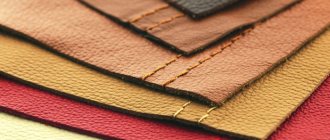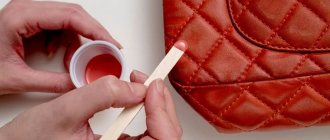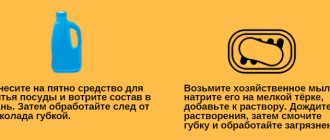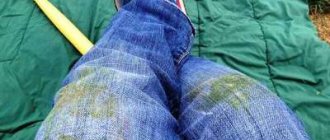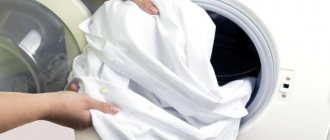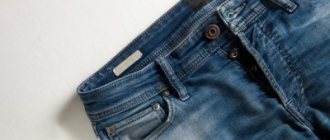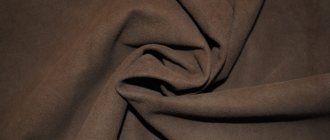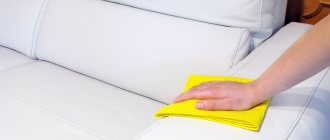Inspect the surface
After studying the information on the label and packaging of the product, you should carefully examine the surface. The material has minor defects that are typical of animal skin. These flaws are microscopic and can only be seen with careful observation.
Slight unevenness and the presence of “grains” and pores on the surface indicate that this is a natural material. If upon inspection small creases and barely noticeable scratches are found, then this is also considered evidence of the animal origin of the raw materials.
Unlike the original, the pressed leather (PU), made from polyurethane, has a smooth surface without flaws. Externally, leatherette is very similar to natural material upon quick inspection.
Product cost
Genuine leather is expensive, which is justified by its service life. The most expensive is cow's, because it has special characteristics. Cowhide can be dyed. It is stronger and more durable.
In the animal materials segment, raw materials also vary in cost. For example, split wood is a material obtained by lamination. It is cheaper than full-grain leather, which is ideal for making belts, boots and other products that require high durability.
Elasticity and color when bending
Another way to check whether the skin is leathery or not is to analyze the color and elasticity. After examining the front surface, you will need to recognize the behavior of the material. To do this, the skin needs to be crushed. The real one will wrinkle and form soft folds, which will smooth out after exposure. The substitute, under force, will resist, trying to maintain its shape and rigidity.
The bright color of the dye cannot serve as a criterion for determining naturalness. Some species are susceptible to coloration and can be misleading.
When subjected to force, natural leather is more elastic than artificial leather, soft wrinkles appear at the site of creasing, and in these areas the color slightly changes shade. Dermantin is difficult to crumple, trying to maintain its shape. In places where the artificial material folds, marks remain in the form of wrinkles.
In some cases this test is difficult to perform. For example, when choosing boots or a pair of shoes. You can focus on tactile sensations: when touched, the leather surface seems warm, despite the fact that leatherette causes a feeling of coolness. This property is also preserved by products made from natural patent leather.
Advantages and disadvantages of eco-leather
Improved production technology makes it possible to obtain eco-leather, which is difficult to visually distinguish from genuine leather. The specifics of the creation affected the quality of the paintings, giving them a number of advantages:
- safety. No plasticizers are added to the material, which give the final product an unpleasant odor. When temperatures fluctuate, the release of toxins is excluded;
- natural air circulation. The porous structure provides ventilation. This quality is taken into account when creating upholstery for furniture and car interiors;
- hypoallergenic. Suitable for people with sensitive sense of smell;
- durability. With proper care, the canvas will retain its original appearance for more than 10 years;
- aesthetics. The fabric is dyed in any shade adding attractiveness to things.
Eco-leather has few disadvantages, which appear when production technology and operating rules are violated:
- When using abrasive cleaning agents, the material loses its elasticity. Scuffs, scratches, and cracks appear at the folds;
- violation of the integrity of the top layer creates holes through which the fabric base is visible.
Note! The quality of the fabric also depends on the manufacturer. It is recommended to purchase items from a trusted seller.
Internal and external coating
It is quite difficult to distinguish genuine leather from fake leather by its outer coating. The modern chemical industry creates new types of leather substitutes that are almost identical in appearance to natural leather. Artfully imitating texture, manufacturers are experimenting with various coatings.
But you can distinguish between the two types of material like this: a natural surface cannot be perfectly smooth. When you pass your hand, you feel heterogeneity. Genuine leather has a rough texture, unlike fake leather.
Important! The surface of genuine leather cannot be large even if it has been subjected to a varnishing process.
The reverse side of the leather is invariably a suede surface. The reverse side of dermantine is a fabric or other textile base. Many manufacturers have learned to imitate suede texture on the reverse side of artificial leather. But even in this case there is a difference: natural suede is heterogeneous, warm when touched.
Checking at home
If you have a leather product at home and want to check its originality, you can do this using an extreme test. Water and fire will help with this.
More details on how to carry out a test at home will be discussed below. Try to carry out the procedure carefully so as not to damage the item.
How to test with fire?
If you have clothes or shoes made of non-genuine leather, if you bring fire to the product, the fabric will melt. You won't see any fire. Black smoke with a pungent odor will be produced. After such a check, the product will have an unpresentable appearance, as a deformation process will occur.
Genuine leather can withstand high temperatures, up to +130°C. Therefore, it is often used in the production of suits for firefighters.
How to test using water?
Lay out the product and drop a little water on it. If the fabric absorbs moisture, it means the clothes are made of genuine leather. Leatherette does not absorb moisture.
Unfortunately, this method cannot be used to test shoes. This is due to the fact that it is coated with a special impregnation so that moisture and dirt remain on the surface. If you pour water on your shoes, the moisture remains on top.
Now you know how to distinguish leather from leatherette. This can be done not only at home, but also in the store. The main thing is to carefully examine the product to understand what kind of leather the shoes or clothes are made from. This can be done by the depth and location of the pores, by the quality of the cut, or by the wrong side. At home, the test can be carried out using water and fire.
Pay attention to edges and seams
It is difficult to get to the cuts and the wrong side of the product. But if such an opportunity exists. It is worth paying attention to the cuts and the reverse side. Reputable manufacturers of leather goods accompany their products with a piece of material (bags, wallets, backpacks). While wearing gloves, you can inspect the cut from the reverse side.
- On leather jackets and coats, it is customary to sew a piece of material under a label with the name of the manufacturer on the reverse side. The sections of the fragment are left open.
- A cut on a genuine leather product may have unevenness both along the cut line and in the thickness of the material. The cut of polymer products is perfectly even. The machine that cuts leatherette parts ensures an even cut.
- The more expensive the product, the more flawless its execution.
- Pay attention to the evenness of the stitching and the stitch spacing. The threads used to stitch the parts of a quality product are strong, their ends do not hang down - they are sealed and hidden.
- The seam of a leather product is durable. The assembly technology necessarily includes gluing the seams with special adhesives. Adhesive smudges on the front side of the seam are not allowed.
For example, the global brand Hermes accepts orders for the manufacture of products several months in advance. Their cost is in the hundreds of thousands. The price of a leather bag, wallet or purse can have a price tag of a million rubles or more.
It's not just about high-quality raw materials. All products from this company are assembled by hand. Moreover, every seam is flawless.
Mass production of leather products cannot afford to perform such painstaking work. The vast majority of factories use traditional sewing methods.
How to distinguish genuine leather from artificial leather
So, let's look at some useful tips that will help us understand whether what is written on the label corresponds to reality.
Product weight
Please pay attention to the weight of the product. Things made of dermantine are lighter than those made of genuine leather. If you already have a similar accessory made from natural material, you can take it with you for comparison.
Product aroma
Learn to distinguish the aroma of natural leather. It should not have the smell of any impurities. If you smell plastic, this indicates that the product is made of leatherette, and, moreover, of poor quality.
Seams
Pay attention to the seams of the products. The seams on dermantine leather are usually smooth, while those on natural leather are slightly rough.
Skin texture
Carefully examine the texture of the skin. Natural material should have pores and small marks. Like the animal itself, they should not be very neat and symmetrical. So, genuine leather has an uneven surface. At the same time, it is very elastic and quickly recovers after compression of the material. Leatherette, in turn, has a smoother surface. However, with the development of technology, the imitation of natural leather is becoming better and better, so we do not stop there and move on to the next step.
Naturalness
Genuine leather behaves like genuine (real) leather. If we squeeze it, it will wrinkle like our own skin. We may even see a slight color change. As soon as we smooth out the skin, it will return to its original appearance. Leatherette does not change its color and retains its texture under mechanical stress.
Thermal conductivity
Place your hand on a product made of genuine leather, after a while the material should warm up and become warm. Faux leather will not heat up and will remain cool.
Inner side
Please note that genuine leather always has two sides. Although all of the above steps are focused on identifying a fake precisely by the outer part of the canvas, the inner surface can also show us something. So, there are small hairs on the inside of natural leather, sometimes the texture resembles suede. Synthetic leather does not have this effect. The only thing we can find on dermantine is fine threads and knitted fibers.
Water experiment
Apply a few drops of water to the product. If water begins to be absorbed, this means that in front of you is a thing made of genuine leather. Water will simply drain from the leatherette.
Mechanical impact
Scratch a leather item with your fingernail a little and a characteristic dent will remain on it. Nothing will happen with high-quality leatherette, but with low-quality leather, the top layer will most likely come off.
Test by fire
For security reasons, we recommend that you perform the last final step only if you have already purchased the product. After all, if you damage an item in a store, the seller will definitely not like it and you will most likely be forced to compensate for losses or be forced to buy this item. So, select a small piece of material, hidden from view, and direct the fire of a lighter or match onto it for a few seconds (up to 10 seconds). What will happen to natural leather? Practically nothing, it will not burn and will not change color. The only thing that can happen is a slight deformation and the release of gas with a mild odor. But artificial leather should quickly set and begin to burn or melt.
The above steps will undoubtedly help you accurately distinguish a fake from an original and choose high-quality products that will serve you for a long time. Also, when choosing products made from genuine leather, you should take into account that the price tag for such things is quite high. Don't chase low prices and discounts. This creates the possibility of falling for the bait of an unscrupulous seller.
Product weight
To recognize what, for example, a jacket or sheepskin coat is made of, it is worth assessing the weight. Clothes or accessories made of leatherette will always be much lighter.
Materials that imitate leather are lightweight and comparable in weight to fabric. While leather items are heavier. For comparison, the consumer can try on leatherette and genuine leather jackets.
The same applies to haberdashery items. When buying a natural backpack or bag, keep in mind that these items are a little heavier.
Some tips on how to check and determine whether leather is genuine or not
- Try not to buy leather products on the market, even if they convince you of the quality of the product and demonstrate checks in all the ways described above. Subsequently, the accessory will turn out to be rough, the seams will fall apart and the surface will fade after a short period of wear. Give preference to branded places of sale with a good reputation.
- Find out what animal the skin belongs to, especially if you are choosing clothes. Buffalo, calf or bull dressing is durable and will last 10 years, while pork is more affordable, but also has the ability to stretch and has a service life of 3-5 years.
- Pay attention to the country of origin. The best goods were brought from Italy and England. Sweden, Germany and France.
- Check the thickness - it should be identical over the entire surface or reinforced in the places where the zipper, armhole is inserted or handles are sewn on.
In the article we told you how to find out and understand whether leather is genuine or not. If you carefully examine the surface, look inside, at the seams and joints, and also remember all the recommendations of experts, you will definitely be able to distinguish a fake. The more ways you try, the more likely you are to find out the truth.
Testing with fire
Another way to establish authenticity is to experiment with setting a piece of material on fire. In a store, the consumer will not be able to perform such a manipulation and the risk of spoiling the item is great. For example, you can ask a furniture manufacturer for a small piece of upholstery taken from the bottom of a sofa or chair.
You need to burn it carefully. Natural leather will swell and char, giving off a burnt hair smell. The artificial material will begin to burn, releasing the characteristic aroma of plastic.
Testing for naturalness using water
The method of checking authenticity using water is one of the simplest and most revealing. Genuine leather absorbs moisture well. If a few drops of water fall on the surface, the material will absorb them within a few seconds.
With similar actions with a good fake, the picture will be different. Artificial polymer materials do not have the ability to absorb, and when drops of water fall on their surface, a puddle is formed. Drops easily roll off leatherette and are not absorbed by the material.
It is not difficult to recognize genuine leather and distinguish it from fakes. In addition, clothing, shoes, furniture upholstery and accessories will create comfort incomparable to synthetic products.
